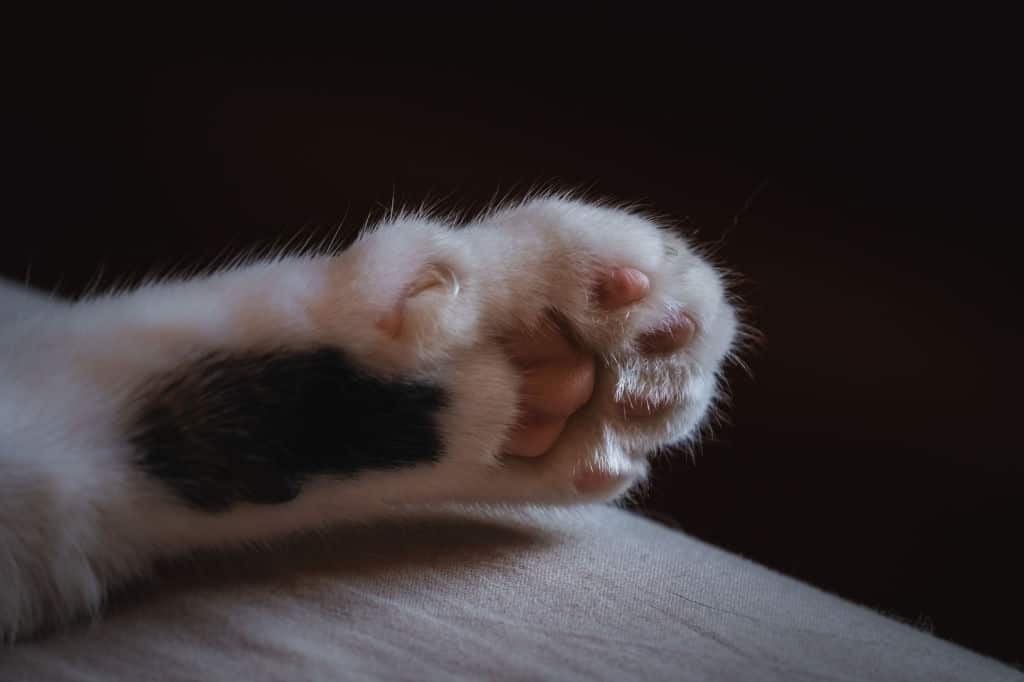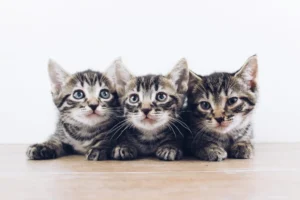Most cats are born with pink pads on their paws. As they age, the pads change color, often to black, and you may see black spots. So, what exactly are these markings?
Black spots on a cat’s paws are usually just skin pigmentation. Pink pads are common in light-colored cats, black pads in black cats, and multi-colored cats can have a mix of colors. They may also change color as a result of sickness or trauma. It’s impossible to remove, yet it’s not dirt.
That is common in many animals. The only issue will be if their skin tone changes or if it’s red or has a discharge that can indicate an infection.

What Is Causing My Cat’s Black Spots on Paws?
Melanin is responsible for this. Melanin is the pigment that defines the color of a cat’s skin, eyes, and fur. It is a pigment in animal and human skin that gives eyes, hair, and skin a darker color. Melanin is determined by genetics – my parents had pale skin, so naturally, I inherited it as well.
There are two kinds of melanin: eumelanin and phaeomelanin. Almost all light is absorbed by eumelanin. It turns fur black and skin gray.
Phaeomelanin reflects light from the red to yellow spectrum, making fur orange and skin pink. As a result, the color depends on the amount of melanin present. Because melanocytes migrate and reproduce as the embryo develops, each cat will have unique markings. Even identical twin cats will differ in certain ways.
The same genes that make different fur colors also make skin different colors. If you shaved your cat down to the skin, the white parts of the fur would leave the skin without color (pink).
And where the fur is black, it would be dark grey. You would usually see grey pads on paws with black fur and pink pads on paws with white fur.

If your cat has dark pads, I don’t think there’s anything to worry about because two of my three cats have black spots on their paws. One of my cats only has one white bean, and the rest are black. However, a trip to the vet won’t hurt if it’s out of the ordinary.
What Should the Color of My Cat’s Paw Pads Be?
White cats typically have light-pink pads, orange cats have orange pads, and tabbies may have brick, red, or gray pads. If your cat’s fur is colorful, chances are their pads are as well. Therefore, the color of the paws is related to the color of the fur.
If you look closely, you’ll notice that the paw with pink pads has a patch of white fur, whereas the paw with black pads does not. The color of the foot pad matches the color of the surrounding hair.
The dark patches may get larger or change shape as the kitten grows. Cats with darker fur patches are likelier to have these spots on their toe beans and paw pads. If you’re concerned that they’re changing shape, size, or texture, consult your veterinarian. Nevertheless, it’s typical for them to be partially pink.
Go to a vet if the color change is painful or makes walking hard, or if the texture changes from smooth, firm toe beans to rough, like a scab or callus, or to a soft, giving blister.
My kitten had this happen on one of his paws, and I assumed it was just pigment, but an unrelated trip to the vet revealed that it was a slight burn of some kind.
What Kind of Cat Has Black Foot Pads?
The cat’s foot pads will reflect the color of its fur, so if the cat is black, its foot pads will also be black.
For instance, breeds like the Bombay cats and black tabby cats often have black foot pads, matching their sleek black fur. However, the paw pad color will occasionally match the nose. Pinkish beans are common in Siamese.
How Would One Recognize a Cat Paw Infection?
If their paws have any moisture or discharge, they may have an infection. Paw infections can result in visible lumps on the paw. These are usually abscesses or pus pockets under the skin. If the paws are dry but red, it could be an allergic reaction.
Remember that an abscess does not form overnight. It can take days or weeks. As the immune system clears the infection, it becomes redder and more inflamed, causing more pressure and pus to leak from the abscess’s point of least resistance. Even though it might not be draining yet, it probably will.
Plasma pododermatitis is a potentially fatal illness with no visible symptoms. This systemic problem causes the plasma to enter and enlarge the foot pad. Unlike other infections, plasma pododermatitis affects all four feet simultaneously, albeit to varying degrees.
FAQs
Why do cats have black spots in their mouths?
Black spots on a cat’s mouth are common and part of the cat’s color pattern. It’s most likely Lentigo, a genetic condition that affects orange, calico, flame point, and tortoiseshell cats. This epidermis darkening is usually harmless in cats, but discussing it with your vet wouldn’t hurt.
Do you need to clean your cats’ paws?
Your cat’s paws should be regularly cleaned. Unhealthy chemicals that attach to their feet may wind up on their tongue when grooming, causing pain. Use wet wipes containing water and/or mild pet-safe cleaners. If you have a lot of patience, you can train a cat to wipe its paws using positive reinforcement.
On a side note, you can train a cat to do many tricks, but training them for protection may not be possible.
What does cat claw fungus look like?
Cats’ nails will be strangely formed, swollen, and yellowish. They are also prone to breaking. Typically, only two nails are impacted. You’ll notice the cat regularly licking, biting, and/or gripping the injured paw. Look at the images below to see what claw fungus looks like and how the cat behaves.


Alex, a passionate animal lover, has experience in training and understanding animal behavior. As a proud pet parent to two dogs and three cats, he founded AnimalReport.net to share insights from animal experts and expand his knowledge of the animal kingdom.









